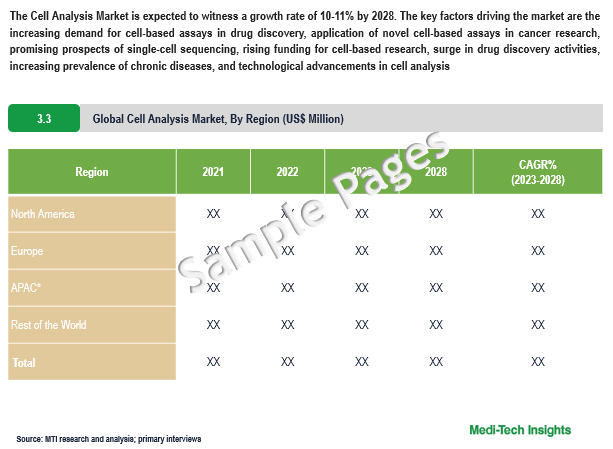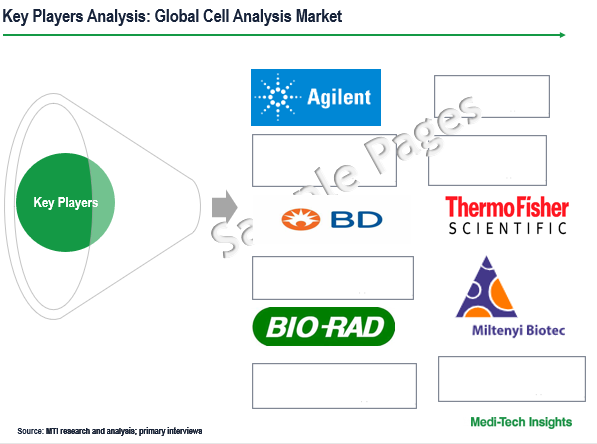
Cell Analysis Market – Global Industry Analysis, Size, Share, Trends and Forecast 2023 to 2028
The Cell Analysis Market is expected to witness a growth rate of 10-11% by 2028. The key factors driving the market are the increasing demand for cell-based assays in drug discovery, rising funding for cell-based research, surge in drug discovery activities, increasing prevalence of chronic diseases, and technological advancements in cell analysis. To learn more about the research, fill out a quick inquiry for a sample report.
Cell analysis involves assessing and quantifying factors such as cell count, cellular condition, viability, proliferation, and chemical and cell-induced toxicity. Cell-based assays provide comprehensive information for basic research, drug discovery and development, and clinical applications.
Advancements in Technology Integration Propel Growth in the Cell Analysis Market
The growth of the cell analysis market is significantly driven by the integration of advanced technologies. This involves merging new technologies with existing ones, resulting in more robust and precise tools for researchers and healthcare professionals. Consequently, there is a discernible upward trend in the adoption of technology integration in cell analysis.
- In May 2023, Deepcell, a leading company in AI-powered single-cell analysis, unveiled the REM-1 platform. This comprehensive platform encompasses benchtop instruments, the Axon data suite, and the Human Foundation Model. Offering high-dimensional cell morphology analysis and sorting, the REM-1 platform combines single-cell sorting, imaging, and analysis, opening new avenues for discovery in fields such as developmental biology, stem cell biology, cancer biology, gene therapy, and functional screening. Deepcell anticipates that its AI-powered approach to cellular analysis will significantly advance biological research, marking the onset of a new era in discovery
- In a parallel development in January 2023, Axion BioSystems expanded its Omni live-cell imaging product family by introducing the Omni Pro 12 platform. Equipped with integrated robotics and a multi-plate design compatible with standard incubators, this platform enhances flexibility and efficiency for live-cell imaging experiments for scientists and drug developers. The Omni Pro 12 is a valuable tool for advancing research in critical areas such as oncology, immunology, and stem cell biology, with the potential to facilitate the development of innovative drugs and therapeutics
Elevated Significance of Cell-Based Screening in Modern Drug Discovery
The uptake of cell-based screening assays has risen in drug discovery endeavours to comprehend the intricacies involved. The advancements in cell biology, bioinformatics, molecular biology, genomics, and proteomics have resulted in substantial data accumulation. Consequently, the significance of utilizing cell-based assays in the drug development pipeline has grown. Similarly, the Human Genome Project has produced numerous targets suitable for drug screening experiments. The swift proliferation of drug targets and leads in recent times has expedited the deployment of cell-based assays for primary and secondary screening in the drug discovery process.
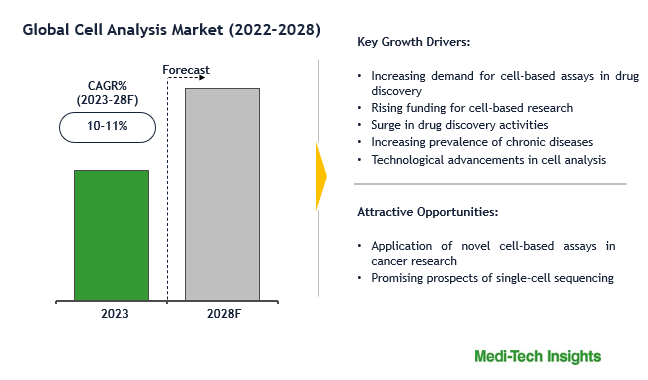
Fill out the "Quick Inquiry Form" to request a sample copy
Cell Analysis Market: Competitive Landscape
Some of the key players operating in the market include Danaher, Thermo Fisher Scientific, Becton Dickinson and Company, Merck KGaA, General Electric, Agilent Technologies, Bio-Rad Laboratories, Olympus Corporation, Fluidigm Corporation, Miltenyi Biotec, Cell Biolabs, Creative Bioarray, BioStatus Limited, NanoCellect Biomedical, Promega Corporation, CELLINK, among others.
Organic and Inorganic Growth Strategies Adopted by Players to Establish Their Foothold in the Market
Players operating in this market are adopting organic and inorganic growth strategies such as launching new products, acquiring related firms, and entering into mergers & collaborations to garner higher market share. For instance,
- In the year 2023, the United States-based company Becton, Dickinson and Company introduced a Spectral Cell Sorter, integrating high-speed cell imaging. This product seamlessly merges real-time imaging technology with spectral flow cytometry
- In Dec 2023, CS Genetics announced that they are working on commercializing a simple, flexible, and easily scalable instrument-free, single-cell analysis technology
The Cell Analysis Market is expected to gain further momentum in the coming years due to the application of novel cell-based assays in cancer research, promising prospects of single-cell sequencing, growing prospects in emerging economies, flourishing biopharma industry, and aggressive organic and inorganic growth strategies followed by the players.
Cell Analysis Market Scope
|
Report Metric |
Details |
|
Market Growth Rate |
The Cell Analysis Market is projected to experience a growth rate of 10-11% by the year 2028. |
|
Key Driving Factors |
|
|
Scope of Cell Analysis |
|
|
Competitive Landscape |
Key players include Danaher, Thermo Fisher Scientific, Becton Dickinson and Company, Merck KGaA, General Electric, Agilent Technologies, Bio-Rad Laboratories, Olympus Corporation, and others. |
|
Market Prospects and Future Momentum |
Expected further momentum in the Cell Analysis Market due to novel cell-based assays in cancer research, prospects of single-cell sequencing, growth in emerging economies, flourishing biopharma industry, and aggressive growth strategies by market players. |
Key Strategic Questions Addressed
- What is the market size and forecast for the Cell Analysis Market?
- What are the historical, present, and forecasted market shares and growth rates of various segments and sub-segments of the Cell Analysis Market?
- What are the major growth drivers, restraints/challenges impacting the market?
- What are the opportunities prevailing in the market?
- What is the investment landscape?
- Which region has the highest share in the market? Which region is expected to witness the highest growth rate in the next 5 years?
- Who are the major players operating in the market? What is the competitive positioning of key players?
- Who are the new players entering the market?
- What are the key strategies adopted by players?
- Research Methodology
- Secondary Research
- Primary Research
- Market Estimation
- Market Forecasting
- Executive Summary
- Market Overview
- Market Dynamics
- Drivers
- Restraints
- Opportunities
- Industry Speaks
- Market Dynamics
- Global Cell Analysis Market - Size & Forecast (2021 - 2028), By Product & Service
- Reagents & Consumables
- Instruments
- Accessories
- Software
- Services
- Global Cell Analysis Market - Size & Forecast (2021 - 2028), By Technique
- Flow Cytometry
- PCR
- Spectrophotometry
- High Content Screening
- Cell Microarrays
- Microscopy
- Other Techniques
- Global Cell Analysis Market - Size & Forecast (2021 - 2028), By End-user
- Hospitals and Clinical Testing Laboratories
- Pharma & Biotech Companies
- Academic & Research Institutes
- Other End-users
- Global Cell Analysis Market - Size & Forecast (2021-2028), By Region
- North America (U.S. & Canada)
- Europe (UK, Germany, France, Italy, Spain, Rest of Europe)
- Asia Pacific (China, India, Japan, Rest of Asia Pacific)
- Rest of the World (Latin America, Middle East & Africa)
- Competitive Landscape
- Key Players and their Competitive Positioning
- Competitive Positioning of Key Players (2022)
- Offerings Assessment, By Players
- Key Strategies Assessment, By Player (2021-2023)
- New Product & Service Launches
- Partnerships, Agreements, & Collaborations
- Mergers & Acquisitions
- Other Developments
- Key Players and their Competitive Positioning
- Key Companies Scanned (Indicative List)
- Danaher
- Thermo Fisher Scientific
- Becton Dickinson and Company
- Merck KGaA
- General Electric
- Agilent Technologies
- Bio-Rad Laboratories
- Olympus Corporation
- Fluidigm Corporation
- Miltenyi Biotec
- Cell Biolabs
- Creative Bioarray
- BioStatus Limited
- NanoCellect Biomedical
- Promega Corporation
- CELLINK
- Other Prominent Players
The study has been compiled based on extensive primary and secondary research.
Secondary Research (Indicative List)
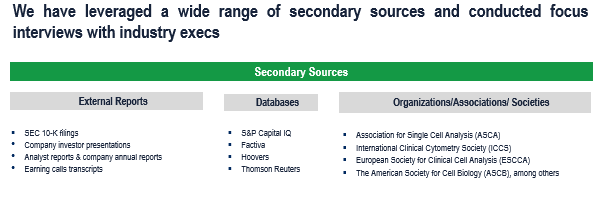
Primary Research
To validate research findings (market size & forecasts, market segmentation, market dynamics, competitive landscape, key industry trends, etc.), extensive primary interviews were conducted with both supply and demand-side stakeholders.
Supply Side Stakeholders:
- Senior Management Level: CEOs, Presidents, Vice-Presidents, Directors, Chief Technology Officers, Chief Commercial Officers
- Mid-Management Level: Product Managers, Sales Managers, Brand Managers, Business Development Managers, Consultants
Demand Side Stakeholders: Hospitals and Clinical Testing Laboratories, Pharma & Biotech Companies, Academic & Research Institutes, among others.
Breakdown of Primary Interviews
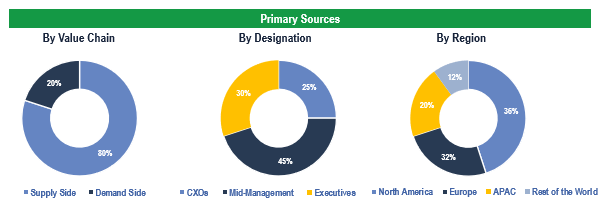
Market Size Estimation
Both ‘Top-Down and Bottom-Up Approaches’ were used to derive market size estimates and forecasts.
Data Triangulation
Research findings derived through secondary sources & and internal analysis were validated with Primary Interviews, Internal Knowledge Repository, and Company Sales Data.
